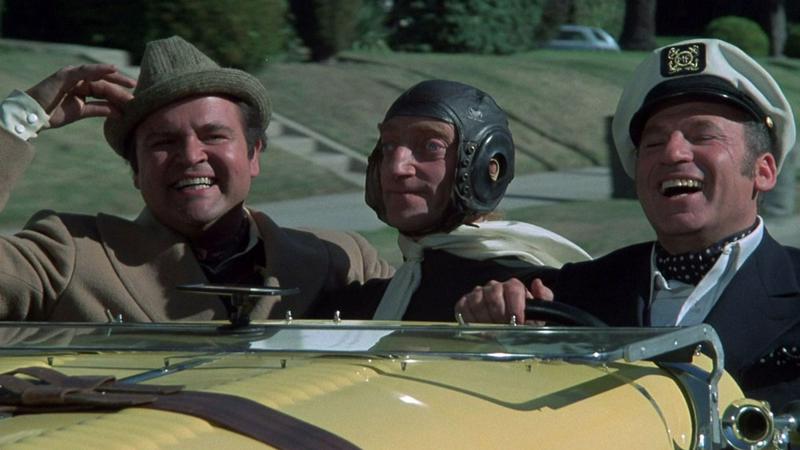Silent Movie: Slapstick In The Seventies
By | August 31, 2021

In 1926, Brooklyn native Mel Brooks was born. He got his start as a writer and comic for Sid Caesar’s Your Show of Shows, which ran from 1950-1954, where he worked alongside Neil Simon, Woody Allen, and Larry Gelbart. With Buck Henry, he also wrote Get Smart (1965-1970). Then 1968, he made his first film, The Producers, which was the start of a string of comedies which would each become one of the top ten moneymakers in the year it was released. Prior to Silent Movie, he released Young Frankenstein and Blazing Saddles; the three films were parodies of entire genres. Silent Movie, however, is not just a gentle parody of a genre, but also a satire of the film industry, criticizing the studios who are not concerned about the quality of their films, the studio executives who are simply yes-men, and the actors, who can be vain.

The Role Of Sound In A Silent Film
Much of the humor in the film is slapstick, just like in the original days of film. As a silent film, sound actually plays a significant role in the humor, however. For example, in one scene which shows the New York City skyline, the song “San Francisco” is playing. The music stops abruptly, making it seem the musicians have realized they are playing the wrong song, and they shift into “I’ll Take Manhattan.” Other gags rely on the way that sound and image work together. In one scene when Feldman is tossed between elevator doors, the sound is that of a pinball machine. The use of intertitles not only provides dialogue, but also adds to the humor. One such intertitle reads “whisper…whisper…whisper,” when an employee whispers in the boss’s ears. When the boss fails to hear, the next intertitle is in all caps as if he was shouting.

An Alcoholic Director's Comeback
Mel Brooks plays the role of Mel Funn, a formerly great film director. He is trying to recover from his drinking problem and revive his career. Along with his sidekicks, Dom Bell (Dom DeLuise) and Marty Eggs (Marty Feldman), Funn heads to Big Pictures Studio, which has the logo “Art is money, a play on the MGM slogan, “Ars gratia artis,” or “Art for art’s sake.” Funn pitches his latest film idea, the first silent film in forty years. Big Studio’s Chief, (Sid Caesar) is unimpressed by the idea. However, Funn sells the idea, claiming he can get the biggest stars in Hollywood to appear, which may save the studio from the villainous conglomerate Engulf & Devour. Incidentally, the name of the nefarious Engulf & Devour mocks Gulf + Western. From 1965 to 1970, Gulf + Western took over eighty separate companies; this included Paramount Pictures in 1966.

One Spoken Word
Once Big Studio is on board, the threesome set out to convince actors. To get Burt Reynolds, they surprise him in his shower and reappear in disguises at his mansion. They find James Caan while filming on location, recruiting him in a dressing room trailer, locate Liza Minelli at the studio commissary, they disguise themselves as Flamenco dancers to cast Anne Bancroft, and, after seeing Paul Newman on the grounds of a hospital, manage to cast him. They try unsuccessfully to cast Marcel Marceau, calling him, and receiving the only spoken word in the entire film, “non.”

Escapades To Make A Film
As they search for stars, the trio deals with a series of misadventures, including Eggs mostly unsuccessful attempts to seduce women, and the soft-drink dispensing machine which launches cans like grenades. Once they have their cast, they have to contend with Engulf & Devour’s attempts sabotage the film. They get Vilma Kaplan (Bernadette Peters), a nightclub singer, to try to seduce Funn, who returns to drinking when he learns of the plan; he returns to drinking, but Kaplan gets Eggs and Bell to find him so they can help him to return to sobriety. Although the film is completed, Engulf & Devour have another plan: to steal the film before the premier. Kaplan stalls the audience as the heroes recover the film and fight off the villains with the soda cans launched from the dispensing machine. After the premiere, which is a huge success, the crowd erupts with applause, and Silent Movie ends indicating it is a “true story.”

The Cheers Were Not Silent
It was nominated for the Golden Globe for Best Picture, and Mel Brooks and Marty Feldman were both nominated for Best Actor, while Bernadette Peters was nominated for Best Actress. Roger Ebert called it “not only funny but fun,” giving it a four-star review. Vincent Canby of The New York Times called it “a virtually uninterrupted series of smiles” and Charles Champlin of the Los Angeles Times wrote, Some of the bits and pieces work better than others, but so many work so clownishly, zanily, idiotically well that 'Silent Movie' is certain to have the year's noisiest audiences.”
